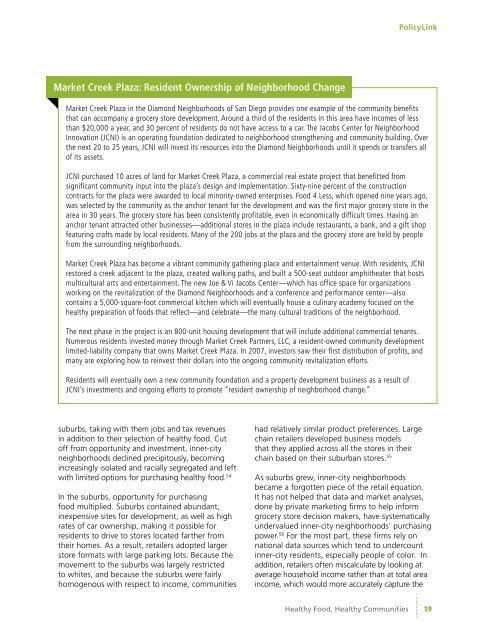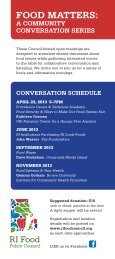Promising Strategies to Improve Access to Fresh, Healthy Food and ...
Promising Strategies to Improve Access to Fresh, Healthy Food and ...
Promising Strategies to Improve Access to Fresh, Healthy Food and ...
Create successful ePaper yourself
Turn your PDF publications into a flip-book with our unique Google optimized e-Paper software.
PolicyLinkMarket Creek Plaza: Resident Ownership of Neighborhood ChangeMarket Creek Plaza in the Diamond Neighborhoods of San Diego provides one example of the community benefitsthat can accompany a grocery s<strong>to</strong>re development. Around a third of the residents in this area have incomes of lessthan $20,000 a year, <strong>and</strong> 30 percent of residents do not have access <strong>to</strong> a car. The Jacobs Center for NeighborhoodInnovation (JCNI) is an operating foundation dedicated <strong>to</strong> neighborhood strengthening <strong>and</strong> community building. Overthe next 20 <strong>to</strong> 25 years, JCNI will invest its resources in<strong>to</strong> the Diamond Neighborhoods until it spends or transfers allof its assets.JCNI purchased 10 acres of l<strong>and</strong> for Market Creek Plaza, a commercial real estate project that benefitted fromsignificant community input in<strong>to</strong> the plaza’s design <strong>and</strong> implementation. Sixty-nine percent of the constructioncontracts for the plaza were awarded <strong>to</strong> local minority-owned enterprises. <strong>Food</strong> 4 Less, which opened nine years ago,was selected by the community as the anchor tenant for the development <strong>and</strong> was the first major grocery s<strong>to</strong>re in thearea in 30 years. The grocery s<strong>to</strong>re has been consistently profitable, even in economically difficult times. Having ananchor tenant attracted other businesses—additional s<strong>to</strong>res in the plaza include restaurants, a bank, <strong>and</strong> a gift shopfeaturing crafts made by local residents. Many of the 200 jobs at the plaza <strong>and</strong> the grocery s<strong>to</strong>re are held by peoplefrom the surrounding neighborhoods.Market Creek Plaza has become a vibrant community gathering place <strong>and</strong> entertainment venue. With residents, JCNIres<strong>to</strong>red a creek adjacent <strong>to</strong> the plaza, created walking paths, <strong>and</strong> built a 500-seat outdoor amphitheater that hostsmulticultural arts <strong>and</strong> entertainment. The new Joe & Vi Jacobs Center—which has office space for organizationsworking on the revitalization of the Diamond Neighborhoods <strong>and</strong> a conference <strong>and</strong> performance center—alsocontains a 5,000-square-foot commercial kitchen which will eventually house a culinary academy focused on thehealthy preparation of foods that reflect—<strong>and</strong> celebrate—the many cultural traditions of the neighborhood.The next phase in the project is an 800-unit housing development that will include additional commercial tenants.Numerous residents invested money through Market Creek Partners, LLC, a resident-owned community developmentlimited-liability company that owns Market Creek Plaza. In 2007, inves<strong>to</strong>rs saw their first distribution of profits, <strong>and</strong>many are exploring how <strong>to</strong> reinvest their dollars in<strong>to</strong> the ongoing community revitalization efforts.Residents will eventually own a new community foundation <strong>and</strong> a property development business as a result ofJCNI’s investments <strong>and</strong> ongoing efforts <strong>to</strong> promote “resident ownership of neighborhood change.”suburbs, taking with them jobs <strong>and</strong> tax revenuesin addition <strong>to</strong> their selection of healthy food. Cu<strong>to</strong>ff from opportunity <strong>and</strong> investment, inner-cityneighborhoods declined precipi<strong>to</strong>usly, becomingincreasingly isolated <strong>and</strong> racially segregated <strong>and</strong> leftwith limited options for purchasing healthy food. 54In the suburbs, opportunity for purchasingfood multiplied. Suburbs contained abundant,inexpensive sites for development, as well as highrates of car ownership, making it possible forresidents <strong>to</strong> drive <strong>to</strong> s<strong>to</strong>res located farther fromtheir homes. As a result, retailers adopted largers<strong>to</strong>re formats with large parking lots. Because themovement <strong>to</strong> the suburbs was largely restricted<strong>to</strong> whites, <strong>and</strong> because the suburbs were fairlyhomogenous with respect <strong>to</strong> income, communitieshad relatively similar product preferences. Largechain retailers developed business modelsthat they applied across all the s<strong>to</strong>res in theirchain based on their suburban s<strong>to</strong>res. 55As suburbs grew, inner-city neighborhoodsbecame a forgotten piece of the retail equation.It has not helped that data <strong>and</strong> market analyses,done by private marketing firms <strong>to</strong> help informgrocery s<strong>to</strong>re decision makers, have systematicallyundervalued inner-city neighborhoods’ purchasingpower. 56 For the most part, these firms rely onnational data sources which tend <strong>to</strong> undercountinner-city residents, especially people of color. Inaddition, retailers often miscalculate by looking ataverage household income rather than at <strong>to</strong>tal areaincome, which would more accurately capture the<strong>Healthy</strong> <strong>Food</strong>, <strong>Healthy</strong> Communities19



